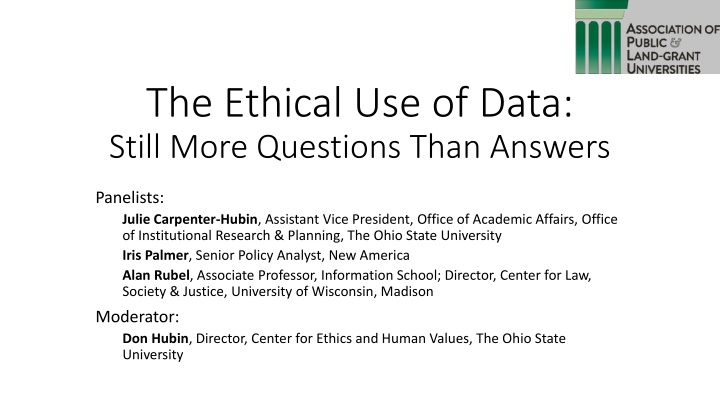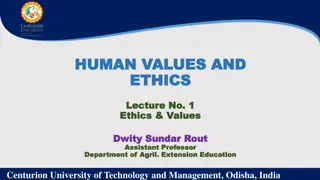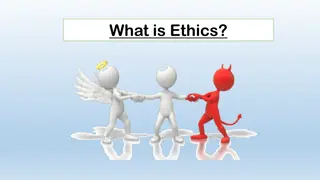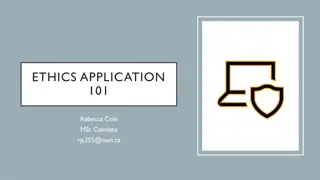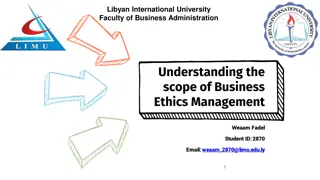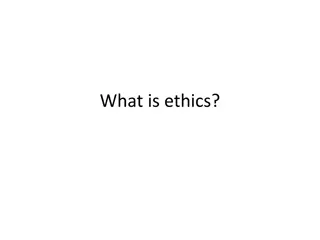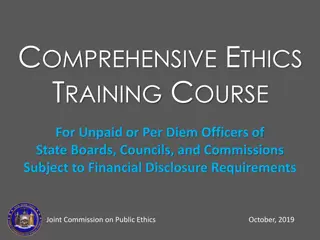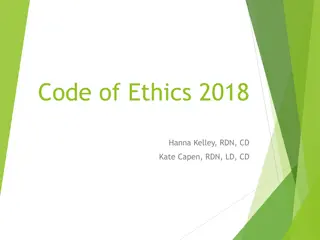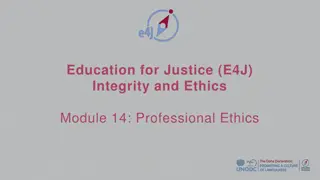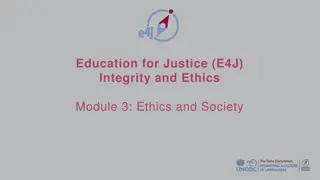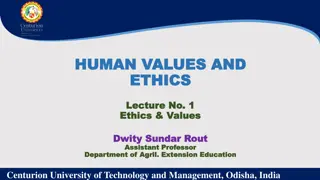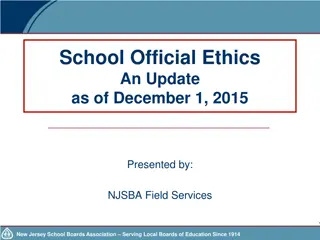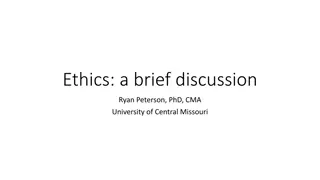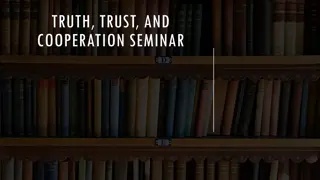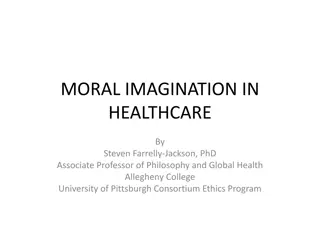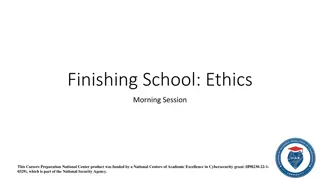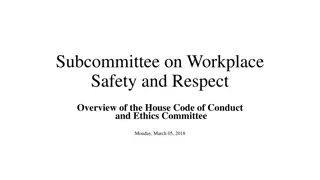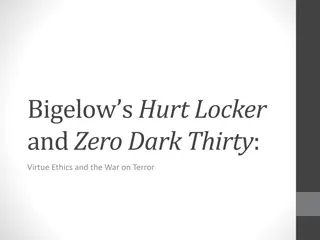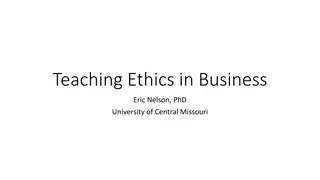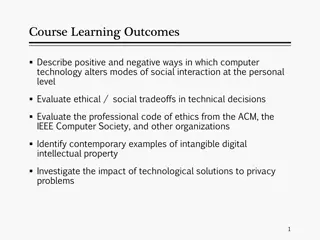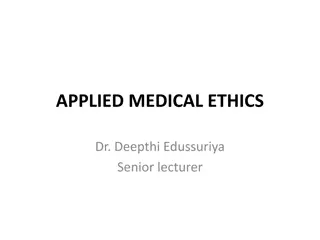Data Ethics: Questions, Uses, Benefits, and Risks
Panelists discuss the ethical use of data, sources like pre-enrollment browsing and healthcare records, current and near-future predictive analytics uses, potential benefits and risks, and the FIPPs approach to privacy protection. Privacy violations, algorithmic bias, and data ownership pose risks, while potential benefits exist for students, institutions, researchers, vendors, and society.
Download Presentation

Please find below an Image/Link to download the presentation.
The content on the website is provided AS IS for your information and personal use only. It may not be sold, licensed, or shared on other websites without obtaining consent from the author.If you encounter any issues during the download, it is possible that the publisher has removed the file from their server.
You are allowed to download the files provided on this website for personal or commercial use, subject to the condition that they are used lawfully. All files are the property of their respective owners.
The content on the website is provided AS IS for your information and personal use only. It may not be sold, licensed, or shared on other websites without obtaining consent from the author.
E N D
Presentation Transcript
The Ethical Use of Data: Still More Questions Than Answers Panelists: Julie Carpenter-Hubin, Assistant Vice President, Office of Academic Affairs, Office of Institutional Research & Planning, The Ohio State University Iris Palmer, Senior Policy Analyst, New America Alan Rubel, Associate Professor, Information School; Director, Center for Law, Society & Justice, University of Wisconsin, Madison Moderator: Don Hubin, Director, Center for Ethics and Human Values, The Ohio State University
Data Sources Pre-application and pre-enrollment browsing Campus web browsing Demographic data from applications Healthcare records SAT/ACT scores, HS GPA, etc. from applications Living situation and financial situation Activity records: campus dining choices; gym use; student club memberships; etc. Degree program and declared major Student surveys and other quantitative data like focus groups Overall performance in previous courses Performance within courses from LMS Alerts from front line faculty and staff Disciplinary records Email content and metadata Student movement based on wireless connection Library records and e-reader records
Current & Near-Future Uses of Predictive Analytics Current Uses Enrollment Management Early Intervention Systems Course of Study Recommender Systems Learning Analytics Alignment of Course Offerings with Student Demand Near-Future Uses
Potential Benefits For Students For Institutions (beyond those for students) For Researchers For Vendors For Society
Potential Risks Privacy Violations Threats to Autonomy Algorithmic Bias Profiling Data Ownership Issues Threats to Faculty/Instructor Intellectual Freedom
FIPPs Approach to Privacy Protection Fair Information Practices Principles Developed by the Federal Trade Commission in 1998, based on notice and consent model. Collection Limitation: There should be limits imposed by lawful and fair means. Purpose Specification: The purposes for which personal data are collected should be specified no later than at the time of data collection and subsequent use limited to the fulfillment of these purposes Use Limitation: Personal data should not be disclosed or otherwise used for purposes other than those specified except with the consent of the data subject, or by the authority of law. Other: Security, openness, individual participation, accountability
Data Minimization The big data business model is antithetical to data minimization. Organizations today collect and retain personal data through multiple channels including the Internet, mobile, biological and industrial sensors, video, e- mail, and social networking tools. Modern organizations amass data collected directly from individuals or third parties, and they harvest private, semi-public (e.g., Facebook), or public (e.g., the electoral roll) sources. Data minimization is simply no longer the market norm. Omer Tene and Jules Polonetsky, Big Data for All: Privacy and User Control in the Age of Analytics, Northwestern Journal of Technology and Intellectual Property, 11, no.5 (2013): 259-260
Purpose Specification The big data business model is antithetical to data minimization. It incentivizes collection of more data for longer periods of time. It is aimed precisely at those unanticipated secondary uses, the crown jewels of big data. After all, who could have anticipated that Bing search queries would be used to unearth harmful drug interactions? Omer Tene and Jules Polonetsky, Big Data for All: Privacy and User Control in the Age of Analytics, Northwestern Journal of Technology and Intellectual Property, 11, no.5 (2013): 259-260
Use Limitation & Consent Today, the widespread and perpetual collection and storage of personal data have become practically inevitable. Every day, people knowingly provide enormous amounts of data to a wide array of organizations, including government agencies, Internet service providers, telecommunications companies, and financial firms. Such organizations -- and many other kinds, as well -- also obtain massive quantities of data through passive collection, when people provide data in the act of doing something else: for example, by simply moving from one place to another while carrying a GPS-enabled cell phone. Indeed, there is hardly any part of one s life that does not emit some sort of data exhaust as a byproduct. And it has become virtually impossible for someone to know exactly how much of his data is out there or where it is stored. Craig Mundie, Privacy Pragmatism: Focus on Data Use, Not Data Collection, Foreign Affairs, March/April 2014
The Ethical Use of Data: Still More Questions Than Answers Panelists: Julie Carpenter-Hubin, Assistant Vice President, Office of Academic Affairs, Office of Institutional Research & Planning, The Ohio State University Iris Palmer, Senior Policy Analyst, New America Alan Rubel, Associate Professor, Information School; Director, Center for Law, Society & Justice, University of Wisconsin, Madison Moderator: Don Hubin, Director, Center for Ethics and Human Values, The Ohio State University
